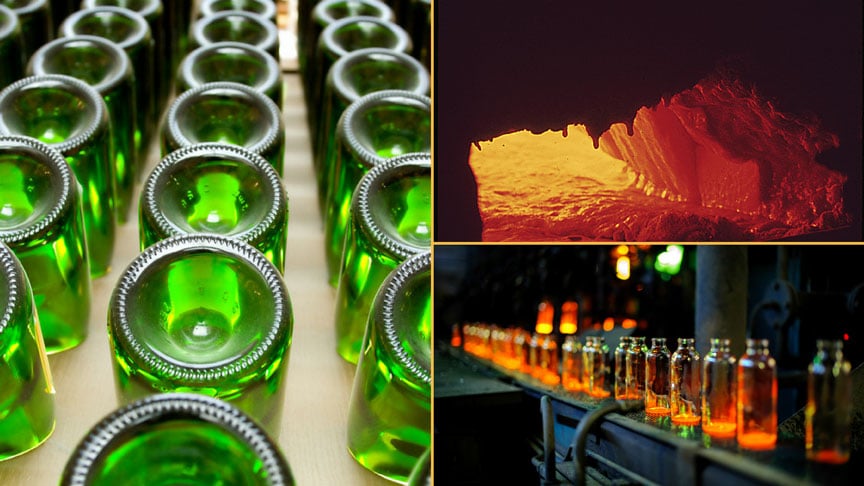This guest blog post was written by Bonnie Crossland, Rosemount product marketing manager for gas chromatographs at Emerson Automation Solutions.
Glass manufacturing is one of the most energy-intensive industries, with energy costs representing roughly 14 percent of the total production costs. The bulk of energy consumed comes from natural gas combustion for heating furnaces to melt raw materials, which are then transformed into glass. Additionally, glass manufacturing is sensitive to the combustion processes, which can affect the quality of the glass and shorten the lifespan of the melting tanks if not managed properly. Historically, the composition of natural gas has been relatively stable. However, dramatic changes in the supply of natural gas (including shale gas and liquefied natural gas imports) are causing end users to experience rapid and pronounced fluctuations in gas quality.
The efficiency of the furnace can be optimized for the air/fuel ratio when the composition of the incoming gas changes. This can significantly reduce energy consumption and provide substantial savings to the business in product quality and equipment life. Optimizing the furnace efficiency has traditionally been complex and costly. Next-generation gas chromatography, however, is changing that paradigm, providing a cost-effective, task-focused methodology that can be carried out by less technically proficient personnel than were traditionally required.

Two unique fuel gas compositions can have the same energy content, but behave very differently in the burner. This is because the different amounts of diluents, nitrogen, and carbon dioxide, and the different ratios of hydrocarbons will cause different densities, and thus, different velocities through the burner restrictors. The Wobbe Index, the ratio of the energy value to the specific gravity (Wobbe Index = energy/√specific density), provides an indicator of how the fuel will act through a burner and provides a better variable to control the air/fuel ratio.
Gas chromatographs are used throughout the natural gas chain of custody (from wellhead to burner tip) to determine the gas composition for quality monitoring and energy content. For pipeline quality natural gas, the industry standard is the C6+ measurement method. This method determines the individual composition for each of the hydrocarbons from methane to normal-pentane, nitrogen, and carbon dioxide, and combines heavier hydrocarbons (e.g., hexane, heptane, octane) as a C6+ component. From the composition, energy content, specific gravity, Wobbe Index, and other physical properties are determined using calculations from international standards such as ISO 6976, GPA 2172, and AGA 8. Using the Wobbe Index and a gas chromatograph to determine the gas composition gives insight into the fuel quality variations from the gas supplier. Additionally, the C6+ measurement is the standard by which custody transfer billing is based, and therefore is a direct method of ensuring that the energy used matches the bill from the gas supplier.
Optimizing the air/fuel ratio
The value of optimizing the air/fuel ratio cannot be overstated. The energy value (British thermal unit [Btu] or calorific value) or Wobbe Index is output from the gas chromatograph via either Modbus or an analog 4–20 mA signal. This signal can be used to integrate with the plant process control system to trim the air/fuel ratio and ensure maximum production efficiency (figure 1). When the air/fuel mixing proportion is correct (stoichiometric), all the fuel will be consumed during the combustion process and will burn cleanly. This enables the furnace to operate at its most efficient, cost-effective point. Changes in the composition of the fuel gas will cause changes in:
- the physical properties of the gas
- the minimum air requirements needed to achieve stoichiometric combustion
- the flue gas composition
- flame speed and flame position
Because glass quality is sensitive to the combustion processes, failing to respond to variations in the composition of the natural gas can result in losing an entire production run due to poor gas quality.
A major glass company in the southeastern U.S. is a heavy user of natural gas. However, the gas comes from multiple locations, causing a constant fluctuation of the Btu value. Because gas flow is adjusted based on the Btu value, knowing the precise measurement is essential. In addition, because the density of the gas varies, knowing the Wobbe Index is critical to quality. When the company began employing a gas chromatograph to optimize its fuel quality, it found the traditional intricacies of gas chromatographs inappropriate for its application. Despite repeated training, its staff was unable to calibrate the instrument. New gas chromatograph technologies designed specifically for natural gas optimization significantly reduced the complexity of operation. In new designs, all of the complex analytical functions of the gas chromatograph may be contained in a replaceable module, greatly simplifying maintenance. Features like auto-calibration make operation easier and more accurate, even for novice users.
Reduced need for specially trained gas chromatograph technicians
At a glass manufacturer in the U.K., poor fuel gas energy measurement led to inadequate air/fuel control, higher energy costs, and a reduction in quality of the finished product. In addition, the company needed compositional data for the calculation of carbon emissions factors, and it lacked a workforce skilled in chromatography. By using new natural gas chromatography technology, it optimized the stoichiometric ratio for stable flame heat, maximized the lifetime of the melting tank, reduced energy costs, and participated in the EU Emission Trading System program. All of this was accomplished without the need for specially trained gas chromatograph technicians.
New gas chromatograph technologies also save costs with capabilities like calibration gas saving features. Self-diagnostics mean the users can rely on the instruments to signal the need for maintenance, while step-by-step on-screen instructions walk the techs through any required processes. The sample handling system includes both particulate and liquid filters and incorporates fixed flow restrictors, removing the need for operators to constantly monitor and adjust the sample system.
Many companies in a wide range of industries faced with the problems of inconsistent quality in natural gas may not have considered gas chromatography as a viable solution for balancing air/fuel ratio due to the traditional complexities of the measurement. It is time to look again. New developments in gas chromatography technology may make this approach the first choice for improving energy efficiency, and ultimately, process quality.
About the Author
 Bonnie Crossland is Rosemount product marketing manager for gas chromatographs at Emerson Automation Solutions.
Bonnie Crossland is Rosemount product marketing manager for gas chromatographs at Emerson Automation Solutions.
Connect with Bonnie:
A version of this article also was published at InTech magazine.
Image source: Wikipedia



